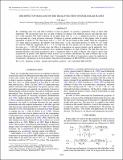| dc.contributor.author | Guo, Jianheng | |
| dc.date.accessioned | 2015-03-05T21:33:01Z | |
| dc.date.available | 2015-03-05T21:33:01Z | |
| dc.date.issued | 2010-04 | |
| dc.date.submitted | 2009-10 | |
| dc.identifier.issn | 0004-637X | |
| dc.identifier.issn | 1538-4357 | |
| dc.identifier.uri | http://hdl.handle.net/1721.1/95901 | |
| dc.description.abstract | By combining mass loss and tidal evolution of close-in planets, we present a qualitative study on their tidal migrations. We incorporate mass loss in tidal evolution for planets with different masses and find that mass loss could interfere with tidal evolution. In an upper limit case (β = 3), a significant portion of mass may be evaporated in a long evolution timescale. Evidence of greater modification of the planets with an initial separation of about 0.1 AU than those with a = 0.15 AU can be found in this model. With the assumption of a large initial eccentricity, the planets with initial mass ≤1 M J and initial distance of about 0.1 AU could not survive. With the supposition of β = 1.1, we find that the loss process has an effect on the planets with low mass at a ~ 0.05 AU. In both cases, the effect of evaporation on massive planets can be neglected. Also, heating efficiency and initial eccentricity have significant influence on tidal evolution. We find that even low heating efficiency and initial eccentricity have a significant effect on tidal evolution. Our analysis shows that evaporation on planets with different initial masses can accelerate (decelerate) the tidal evolution due to the increase (decrease) in tide of the planet (star). Consequently, the effect of evaporation cannot be neglected in evolutionary calculations of close-in planets. The physical parameters of HD 209458b can be fitted by our model. | en_US |
| dc.description.sponsorship | Chinese Academy of Sciences (Western Light Talent Culture Project, 08AXB31001) | en_US |
| dc.description.sponsorship | Chinese Academy of Sciences (Knowledge Innovation Program, 07ACX21001) | en_US |
| dc.description.sponsorship | National Natural Science Foundation of China (No. 10803018) | en_US |
| dc.language.iso | en_US | |
| dc.publisher | Institute of Physics/American Astronomical Society | en_US |
| dc.relation.isversionof | http://dx.doi.org/10.1088/0004-637x/712/2/1107 | en_US |
| dc.rights | Article is made available in accordance with the publisher's policy and may be subject to US copyright law. Please refer to the publisher's site for terms of use. | en_US |
| dc.source | American Astronomical Society | en_US |
| dc.title | THE EFFECT OF MASS LOSS ON THE TIDAL EVOLUTION OF EXTRASOLAR PLANET | en_US |
| dc.type | Article | en_US |
| dc.identifier.citation | Guo, J. H. “THE EFFECT OF MASS LOSS ON THE TIDAL EVOLUTION OF EXTRASOLAR PLANET.” The Astrophysical Journal 712, no. 2 (March 10, 2010): 1107–1115. © 2010 American Astronomical Society. | en_US |
| dc.contributor.department | Massachusetts Institute of Technology. Department of Earth, Atmospheric, and Planetary Sciences | en_US |
| dc.contributor.mitauthor | Guo, Jianheng | en_US |
| dc.relation.journal | Astrophysical Journal | en_US |
| dc.eprint.version | Final published version | en_US |
| dc.type.uri | http://purl.org/eprint/type/JournalArticle | en_US |
| eprint.status | http://purl.org/eprint/status/PeerReviewed | en_US |
| dspace.orderedauthors | Guo, J. H. | en_US |
| mit.license | PUBLISHER_POLICY | en_US |
| mit.metadata.status | Complete | |
